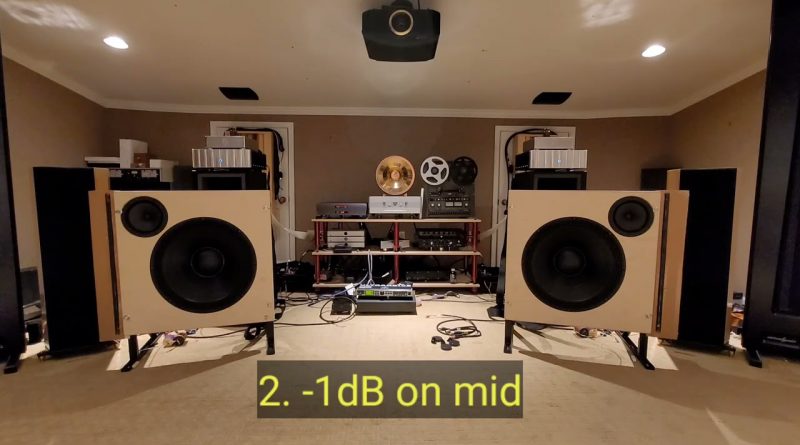How to tune speaker response for your room !! This is also how you make the crossover.
Baseline – all zeroed out xover at 400Hz and 2600 Hz 3:24
1. Remove tweeter 2 Ohm resistor (pad) from tweeter, now tweet is 2 Ohm 5:45
2. -1dB on Mid 7:34
3. Drop Xover point to 100Hz from 400Hz (all are 4th order L/R) 11:52
4. bring xover point up to 200Hz 14:38
5. Take xover point down to 150Hz and boost 1dB on low bass 16:45
6. +1dB on High 18:48
7. +1db on High 20:16
8. Adjust room balance by volume (louder) 23:18
9. +.5dB on Tweeter/. Move Xover point down to 127Hz 27:18
10 +1dB Mid 28:39
11. -0.5dB Mid 29:14
12. +0.2db Woofer 31:03
13. +0.2dB Tweeter 32:20
again 33:20
14. -0.1 dB Midrange 34:08
15. Take xover point down to 121Hz from 127Hz 35:32
OK Tribe here is a very basic and pragmatic way to tune speakers. Once I complete this step I add measurement to see how the curve looks , then can fine tune doing the broad strokes using measurement then the fine strokes by ear .
For this whole experiment I started with a very simple square flat baffle and cut 2 holes for woof and full range driver. Later added a tweeter ribbon on the side for a 3 way design. So its easy then to guess at where the crossover points will be, and thats how I set the Xower. Based on my 2 points then I zero all the 3 outputs to be even and thats the baseline from which I start. In this example I do it all by ear. Next Ill use a microphone and analysis software to determine how flat the response is. Remember the best sounding response is never ruler flat it will be +/- 5dB from flat 20 to 20 and this variance is what gives speakers thier character . if you can get +/- 5dB from 20 Hz to 20Khz, Im guessing that puts us in the top 10% of audio systems worldwide. You would be amazed at how many speakers come from the factory with wonky frequency response. I mean we count on these people to do this accurately. This is not always the case.
atoll logiciel



